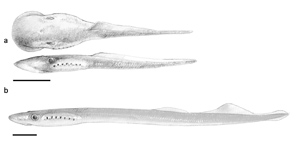|
||
      |
Citations
Superbug’s kryptonite
It’s hard to keep up with Staphylococcus
aureus. A ubiquitous bacteria that causes most hospital-based infections
and an increasing number of diseases in the world at large, the microbe
is adept at building resistance to antibiotics. In 1972 only 2 percent
of staph infections were drug-resistant; by 2004 that number reached 63
percent. Previous vaccination attempts yielded only partial immunity, but
in the November 7 Proceedings of the National
Academy of Sciences, microbiologist Olaf Schneewind reports
on a vaccine that offers mice complete protection against two virulent
S. aureus strains. Against three other strains, inoculated mice showed
a 60- to 90-percent survival rate. Schneewind and his team developed the
vaccine by sifting through the S. aureus genome to find proteins that fire
up the human immune system.

The lamprey’s unchanging physique.
Neighborhood tipping point
Forty-two years after the 1964 Civil Rights
Act passed, racial integration remains an elusive dream, write Chicago
sociologist Richard P.
Taub and his Harvard coauthor William Julius Wilson, who taught
at Chicago from 1972 to 1996. In There Goes the Neighborhood: Racial,
Ethnic, and Class Tensions in Four Chicago Neighborhoods and their Meaning
for America (Alfred A. Knopf, 2006), the scholars analyze four pseudonymous
working-class communities to determine why some neighborhoods see rapid
racial and economic shifts while others remain more stable. Taub and Wilson
conclude that strong local social organizations help stave off the “tipping
point” at which neighborhoods flip from middle-class white to poor
black or Latino.
Living fossil
Without jaws, true teeth, paired fins, or scales, the lamprey—an
eel-like parasite that adheres to other fish—has hardly changed in
360 million years. That’s the age of a fossil unearthed in 2005 in
a South African estuary, and Chicago evolutionary biologist Michael
Coates, along with two Johannesburg colleagues, say the discovery
proves the fish is a holdover from primitive marine ecosystems. Considered
an evolutionary precursor to modern fish, lampreys today thrive in temperate
rivers and coastal seas. Yet their fossils are rare, and the South African
find, detailed in the October 26 Nature, roots the animal’s
modern morphology deep within the Paleozoic period.
An answer to the abuse cycle
Psychologists have long observed that abuse
perpetuates across generations—that
abused offspring often abuse their own offspring—and in the October Behavioral
Neuroscience, psychobiologist Dario Maestripieri offers
an explanation. His research team found that month-old rhesus monkeys that
experienced maternal rejection and abuse produced less serotonin than their
nurtured peers. Low levels of the neurotransmitter correspond with anxiety,
depression, and impulsive aggression in both monkeys and humans. Maestripieri’s
research is the first to demonstrate that a mother’s behavior can
affect her offsprings’ brain development. The findings suggest, he
says, that treating an abused infant with serotonin-boosting drugs could
reduce the child’s chances of becoming an abuser later in life.
Long-term education investment
Preschool raises disadvantaged children’s
chances of staying in school and out of jail. But what if, wondered economist James Heckman,
those youngsters continued to be tutored and mentored through high school?
In a study released November 15, Heckman and PhD student Flavio
Cunha used data from the 1979 National Longitudinal Study of Youth
to model the effects of sustained investment. They found such a commitment
raised children’s high-school graduation rates to 90 percent and
college-enrollment rates to 37 percent. For preschool alone, those figures
were 65 percent and 12 percent.